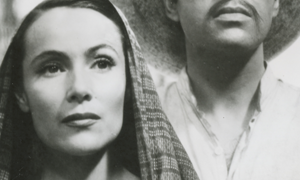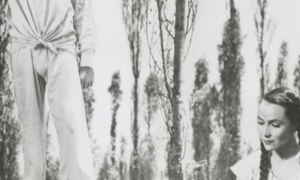Maria Candelaria / Xochimilco
Sponsored by The Mexican Cultural Center
About the Film
Starring Dolores del Rio and Pedro Armendariz, Maria Candelaria was the first Mexican film to be screened at the Cannes International Film Festival, and the first Latin American film awarded the Gran Prix. Gabriel Figueroa, the film’s cinematographer, was nominated for an Academy Award for The Night of the Iguana, and is often referred to as “the Fourth Muralist” of Mexico.
A young journalist presses an old artist (Alberto Galán) to show a portrait of a naked indigenous woman that he has in his study. The body of the movie is a flashback to Xochimilco, Mexico, in 1909. The film is set right before the Mexican Revolution, and Xochimilco is an area with beautiful landscapes inhabited mostly by indigenous people.
The woman in the painting is María Candelaria (Dolores del Rio), a young Indian woman who is constantly rejected by her own people for being the daughter of a prostitute. She and her lover, Lorenzo Rafael (Pedro Armendariz), face constant struggles throughout the film. They are honest and hardworking, yet nothing ever goes right for them. Don Damian (Miguel Inclán), a jealous Mestizo store owner who wants María for himself, prevents them from getting married. He kills a piglet that María and Lorenzo plan to sell for profit and he refuses to buy vegetables from them. When María falls ill with malaria, Don Damian refuses to give the couple the quinine medicine necessary to fight the disease. Lorenzo breaks into his shop to steal the medicine, and he also takes a wedding dress for María. Lorenzo goes to prison for stealing, and María agrees to model for the painter to pay for his release. The artist begins painting a portrait of María, but when he asks her to pose nude she refuses.
The artist finishes the painting with the nude body of another woman. When the people of Xochimilco see the painting, they assume it is María Candelaria and stone her to death.
Finally, Lorenzo escapes from prison to carry María's lifeless body through Xochimilco's canal of the dead.
About Gabriel Figueroa
From the early 1930s through the early 1980s, the Mexican cinematographer Gabriel Figueroa (1907–1997) helped forge an evocative and enduring image of Mexico. Among the most important cinematographers of the so-called Golden Age of Mexican Cinema, Figueroa worked with leading directors from Mexico, the United States and Europe, traversing a wide range of genres while maintaining his distinctive and vivid visual style. In the 1930s, Figueroa was part of a vibrant community of artists in many media, including Diego Rivera, Jose Clemente Orozco, Edward Weston and Manuel Alvarez Bravo, who sought to convey the country’s transformation following the trauma of the Mexican Revolution. Later, he adapted his approach to the very different sensibilities of directors Luis Buñuel and John Huston, among others. Figueroa spoke of creating una imágen mexicana. His films are an essential part of the network of appropriations, exchanges and reinterpretations that formed Mexican visual identity and visual culture in the mid-twentieth century and beyond.
Program presented in collaboration with Mexican Cultural Center and the Mexican Consulate. Invited speaker Gabriel Figueroa Flores, son of Gabriel Figueroa.



